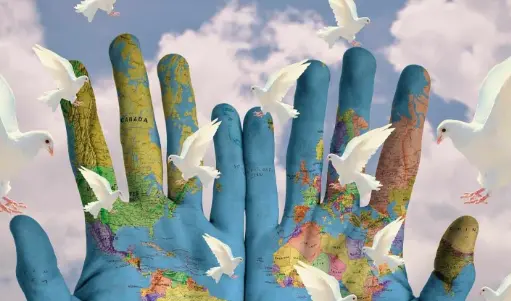The UN: Weaving a Tapestry of World Peace
The world we live in is a complex web of nations, each with its own history, culture, and aspirations. Throughout history, this intricate tapestry has been marred by conflict, leaving a trail of human suffering. In the aftermath of the devastating Second World War, a collective resolve emerged to prevent such large-scale tragedies from ever happening again. This yearning for peace gave birth to the United Nations (UN) in 1945.
Etched in the very first words of its Charter, the UN’s core mission is “to save succeeding generations from the scourge of war.” This lofty ideal translates into a multifaceted approach to world peace. Here, we delve into the various threads the UN weaves to create a more peaceful world.
1. Preventing Conflict: A Stitch in Time
The old adage, “prevention is better than cure,” holds for the UN’s approach to conflict. Proactive measures are crucial in addressing the root causes of war, such as poverty, inequality, and human rights abuses. The UN tackles these challenges through:
-
Early Warning and Preventive Diplomacy: The UN monitors potential flashpoints around the world, identifying situations with the potential to escalate. This allows for early intervention through diplomatic channels, fostering dialogue and de-escalation.
-
Peacebuilding: Following conflicts, the UN works to create lasting peace by addressing underlying grievances, promoting reconciliation, and fostering democratic institutions. This fosters a more stable environment where peace can take root.
2. Peacekeeping: Holding the Line
When conflicts do erupt, UN Peacekeeping plays a vital role. Peacekeepers, often referred to as “blue helmets” due to their distinctive headwear, are deployed to conflict zones with the consent of the parties involved. Their primary mission is to:
-
Monitor Ceasefires: Peacekeepers act as impartial observers, ensuring compliance with ceasefire agreements between warring parties. This helps to stabilize the situation and prevent further violence.
-
Protect Civilians: The safety and well-being of civilians caught in the crossfire is paramount. Peacekeepers provide humanitarian assistance, protect refugees, and prevent human rights abuses.
-
Support Peace Processes: Peacekeeping missions can create the space for dialogue and negotiation between warring parties. They can also facilitate the disarmament of combatants and the reintegration of former fighters into society.
3. The Security Council: A Powerful Thread
The UN Security Council holds primary responsibility for maintaining international peace and security. This 15-member body, however, faces challenges due to the veto power wielded by its five permanent members – China, France, Russia, the United Kingdom, and the United States. Despite this complexity, the Security Council plays a critical role in:
-
Authorizing Peacekeeping Operations: The Security Council mandates the deployment of peacekeepers and defines their mission parameters. This ensures clear and unified action from the UN.
-
Enforcing Peace: In extreme cases, the Security Council can authorize the use of force to maintain peace. This is a last resort, often a complex and controversial undertaking.
-
Addressing Threats to Peace: The Security Council addresses a wide range of threats to peace, including terrorism, weapons proliferation, and cyberattacks. It fosters international cooperation in tackling these global challenges.
4. Building a More Peaceful World: Beyond Conflict Resolution
The UN’s pursuit of world peace extends beyond conflict resolution. It recognizes that lasting peace can only be achieved by addressing broader issues that fuel conflict:
-
Sustainable Development: Poverty, inequality, and lack of access to resources can all contribute to conflict. The UN’s Sustainable Development Goals (SDGs) aim to tackle these issues, creating a more just and equitable world.
-
Human Rights: Respect for fundamental human rights is essential for peaceful societies. The UN promotes and protects human rights through various treaties and mechanisms, empowering individuals and fostering a culture of peace.
-
Disarmament: The proliferation of weapons, particularly weapons of mass destruction, poses a significant threat to peace. The UN works towards disarmament and arms control treaties, advocating for the reduction of global stockpiles.
The UN: A Work in Progress
The UN is not without its critics. Challenges like bureaucratic hurdles, power imbalances among member states, and the difficulty of enforcing resolutions can sometimes hinder its effectiveness. However, despite these limitations, the UN remains the only global forum where all nations can come together to address the challenges of war and peace.
Looking Ahead: Weaving a Brighter Future
The pursuit of world peace is an ongoing endeavor. As the world faces new and complex security threats, the UN must adapt and evolve. By fostering collaboration, strengthening preventive measures, and addressing the root causes of conflict, the UN can continue to weave a tapestry of peace.


Comments are closed, but trackbacks and pingbacks are open.